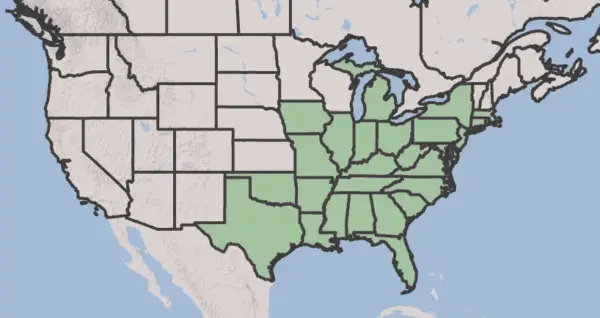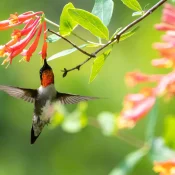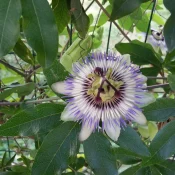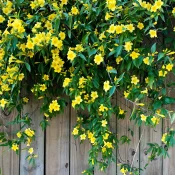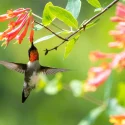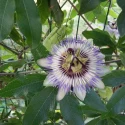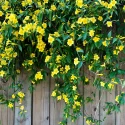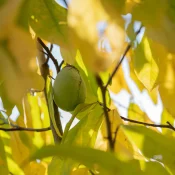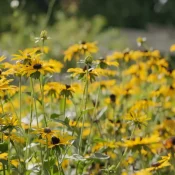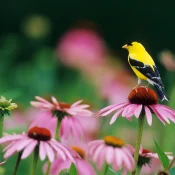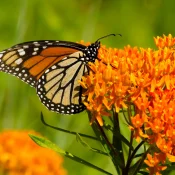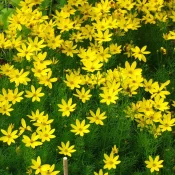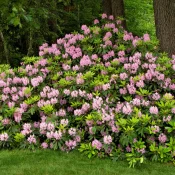American Wisteria
American Wisteria is a simply beautiful vine. They can be trained to grow on a trellis, structure, or fence, or can be pruned to a shrub. The native species blooms with blue-purple flowers in the late spring/early summer and sometimes again in the fall. Dig up (or stay away from) Japanese or Chinese Wisteria, both of which are invasive plants. American Wisteria is native to a wide swath of the United States, from Pennsylvania down to Florida, and west to Illinois. There is also a cultivar made for cold climates. Scroll on to learn more.
- Full Sun, Part Sun
- Vine
- Summer flowers, Fall flowers
- Easy to find
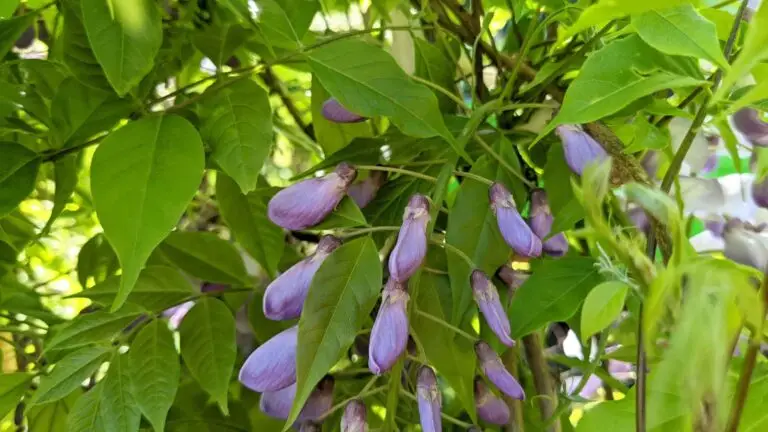
What are the benefits of planting American Wisteria?
Planting native plants like American Wisteria makes our yards and spaces gorgeous while helping the birds, butterflies, and animals (and helping save us time!) Here are three reasons why planting native is worth it:
- Without native plants, iconic animals like Monarch butterflies and songbirds won’t have the food or homes needed to survive
- Native plants save time and money: after the first year of getting established, native plants are happy with rain
- Native plants are gorgeous! American Wisteria is a perfect example of how beautiful and resilient native plants are—they are always the best choice for our gardens.
Where is American Wisteria native?
American Wisteria is native to a large part of the eastern US, from Massachusetts and New York down to Florida, and west to Texas.
Beware of invasive non-native wisteria!
Be mindful when planting wisteria to stay away from non-native species. Japanese wisteria (Wisteria floribunda) and Chinese wisteria (Wisteria sinensis) are infamous for their rapid growth and ability to smother native plants.
When selecting a wisteria for your garden, always choose native varieties like American wisteria (Wisteria frutescens) to avoid ecological disruption and enjoy minimal-care gardening.
How can I tell the difference between native and non-native wisteria?
Unfortunately, it can be difficult to tell native and non-native wisterias apart. All three make purple flowers, and all have similar-looking vines.
The easiest way to tell non-native and native wisteria plants apart is to look at their seed pods.
- Chinese and Japanese Wisteria make fuzzy seed pods
- American Wisteria’s seed pods are smooth
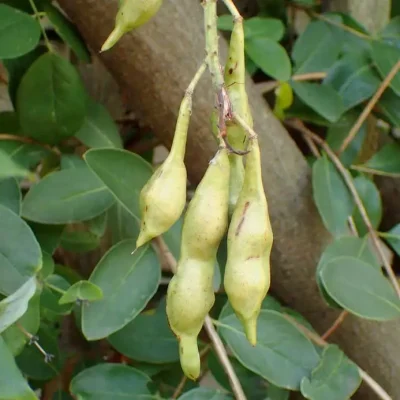
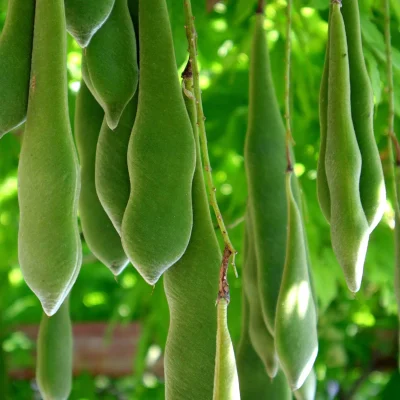
If you’re in the American South and spot blooming wisteria along highways or neighborhood streets in March or April, you’re almost certainly looking at the invasive, non-native species.
Bloom time also helps identify native vs. non-native
And good way to tell is their blooming time. Chinese and Japanese Wisteria bloom earlier than native American Wisteria.
If you’re in the American South and spot blooming wisteria along highways or neighborhood streets in March or April, you’re almost certainly looking at the invasive, non-native species. American Wisteria blooms later—June/July typically.
How can I make sure I’m getting American Wisteria?
When buying wisteria, look at the Latin name to ensure it’s the native variety. If you see the Latin name ‘Wisteria frutescens’ —you’ve found American Wisteria. Plant away!
If you’re at a nursery and it doesn’t include a plant name tag with the Latin name—be wary. Find a reputable native nursery that includes Latin names. Here are 300+ native nurseries to help.
Planting FAQs
Does American Wisteria need full sun to bloom?
Yes, American wisteria thrives in full sun for optimal blooming. While it can grow in partial shade, too much shade will result in reduced flowering and more leafy growth. Plant it in a spot that gets at least 6–8 hours of direct sunlight daily.
When should I prune American Wisteria?
While native wisteria is less aggressive than its invasive counterparts, it can still benefit from regular pruning. Trim American Wisteria in late winter or early spring to encourage a bushier, more controlled shape. Remove any dead or diseased branches to keep the plant healthy.
A note on pruning and flowers
American Wisteria makes most of its flowers on old wood—meaning the growth from seasons past. To have as many flowers as possible, prune new growth and leave the older growth alone.
Is there an American Wisteria for cold climates?
The American Wisteria cultivar ‘Betty Matthews’ has been grown to be hardy in winter-friendly Minnesota. This cold-hardy cultivar was identified by Woody Landscape Plant Breeding and Genetics Program (WLPBGP). The WLPBGP identifies and develops “new, cold-hardy woody landscape plants for Minnesota and the surrounding environs.”
American Wisteria ‘Betty Matthews’ was the first vine added to WLPBGP’s list. Call local native nurseries to see if they have some in stock for you—here’s our list of 300+ nurseries to make finding one easier.
When does American Wisteria bloom?
American Wisteria blooms in June/July and sometimes again in the fall. There is also a cultivar called ‘Amethyst Falls’ that is cultivated to always bloom in June/July and again in the fall.
If you see wisteria blooming in the south in early spring (Apr/May), it’s most likely one of the Asian varieties. Bloom times are another way to tell non-native and native species apart.

Where should I plant American Wisteria?
American Wisteria is perfect for fences, trellis, or arbors. Its showy flowers will cascade down in the spring. When the plant is happy and mature, it often blooms again in the fall.
American Wisteria is a perennial, meaning plant once and enjoy it for years.
Gardener enthusiast P. Allen Smith has a helpful overview video that gives inspiration on where to plant American Wisteria and examples of how to train it using twine.
No pesticides or herbicides
Avoid using pesticides or herbicides near American Wisteria, as they can harm the butterflies and pollinators that visit the plant.
Are there any other vining native plants?
So glad you asked! If you’re looking for other native vines, here you go:
Where can I buy American Wisteria?
We’re not going to lie, sometimes finding native plants can be a challenge. To make it easier, here are four sources for native plants (some in your community):
Where can I find seeds and plants?
Finding native plants can be challenging (we partly blame Marie Antoinette.) To make it easier, we’ve assembled four sourcing ideas.
Native Nursery List
300+ native nurseries makes finding one a breeze
Online Native Plant Sellers
We've included 100+ online resources to help
Society Plant Sales
Every state has a native plant society; find yours
Online Communities
Local Facebook groups are a great plant source
What should I plant with American Wisteria?
American Wisteria prefers full sun or part sun, much like dozens of other native shrubs, vines, and flowers. If you’re planting in a wetter area, pair with Buttonbush and Cardinal Flower. If the area is drier and sunny, pair with Coneflowers, Asters, Sweetbay Magnolia, and False Blue Indigo.
Native flower pairings
Native shrub pairings
Native American Wisteria is a gorgeous, easy-to-grow native vine (or shrub if you prune it!) Because they are perennials, plant them once and they will come back year after year. Spend a morning or afternoon planting an American Wisteria and it will return decades of fuss-free beauty. Happy planting!
Sources
Sources
- Nelson, Gil. Best Native Plants for Southern Gardens: A Handbook for Gardeners, Homeowners, and Professionals, (2010), 387-388.
- Garden Design, Types of Wisteria.
- Hokanson, Stan C., Steven McNamara, Kathryn Zuzek, Mike Zins, and Nancy Rose. “Wisteria frutescens, American Wisteria, ‘Betty Matthews’ First Editions® Summer Cascade™”, HortScience horts 50, 2 (2015): 317-319. https://doi.org/10.21273/HORTSCI.50.2.317
